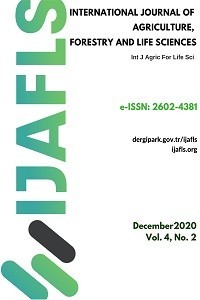Antioxidant activity, total phenolic compounds and ld50 bioassay (toxicity) activity of the fermented wood “Nikhra” fractions of combretum hartmannianum, terminalia laxiflora and acacia seyal
Antioxidant activity, total phenolic compounds and ld50 bioassay (toxicity) activity of the fermented wood “Nikhra” fractions of combretum hartmannianum, terminalia laxiflora and acacia seyal
Antioxidant activity;, Phenolic compounds;, Phenolic acids; Flavonoids;, Tannins;, Free radical;, Toxicity activity,
___
- Abdel-Farid, I., Sheded, M., and Mohamed, E. (2014). Metabolomic profiling and antioxidant activity of some Acacia species. Saudi Journal of Biological Sciences 21, 400-408. Aberoumand, A., and Deokule, S. (2008). Comparison of phenolic compounds of some edible plants of Iran and India. Pakistan Journal of Nutrition 7, 582-585.
- Al-Fartosy, A. J. (2011). Antioxidant properties of methanolic extract of Inula graveolens L. Turkish Journal of Agriculture and Forestry 35, 591-596.
- Boersma, B. J., Patel, R. P., Kirk, M., Jackson, P. L., Muccio, D., Darley-Usmar, V. M., and Barnes, S. (1999). Chlorination and nitration of soy isoflavones. Archives of biochemistry and biophysics 368, 265-275.
- Chang, S.-T., and Tung, Y.-T. (2009). Acacia extracts and their compounds on inhibition of xanthine oxidase. Google Patents.
- Chun, S.-S., Vattem, D. A., Lin, Y.-T., and Shetty, K. (2005). Phenolic antioxidants from Clonal oregano (Origanum vulgare) with antimicrobial activity against Helicobacter pylori. Process Biochemistry 40, 809-816.
- Dudonne, S., Vitrac, X., Coutiere, P., Woillez, M., and Mérillon, J.-M. (2009). Comparative study of antioxidant properties and total phenolic content of 30 plant extracts of industrial interest using DPPH, ABTS, FRAP, SOD, and ORAC assays. Journal of Agricultural and Food Chemistry 57, 1768-1774. DOI: 10.1021/jf803011r
- Estevinho, L., Pereira, A. P., Moreira, L., Dias, L. G., and Pereira, E. (2008). Antioxidant and antimicrobial effects of phenolic compounds extracts of Northeast Portugal honey. Food and Chemical Toxicology 46, 3774-3779. doi.org/10.1016/j.fct.2008.09.062
- Fyhrquist, P., Mwasumbi, L., Hæggström, C.-A., Vuorela, H., Hiltunen, R., and Vuorela, P. (2002). Ethnobotanical and antimicrobial investigation on some species of Terminalia and Combretum (Combretaceae) growing in Tanzania. Journal of Ethnopharmacology 79, 169-177. DOI: 10.1016/s0378-8741(01)00375-0
- Halliwell, B., and Gutteridge, J. M. (1995). The definition and measurement of antioxidants in biological systems. Free Radical Biology and Medicine 18, 125-126.
- Hassan, L. E., Ahamed, M. B., Majid, A. S., Baharetha, H., Muslim, N. S., Nassar, Z. D., and Majid, A. M. (2014). Correlation of antiangiogenic, antioxidant and cytotoxic activities of some Sudanese medicinal plants with phenolic and flavonoid contents. BMC Complementary and Alternative Medicine 14, 406. https://doi.org/10.1186/1472-6882-14-406
- John B Hall. (1994). NFTA 94-07. School of Agriculture and Forest Sciences, University of Wales, Bangor, Gwynedd LL57 2UV, UK.
- Kamali, H., and Mohammed, M. (2007). Antibacterial activity of Hibiscus sabdariffa, Acacia seyal var. seyal and Sphaeranthus suaveolens var. suaveolens against upper respiratory tract pathogens. Sudan Journal of Medical Sciences 1, 121-126.
- Khalaf, N. A., Shakya, A. K., Al-Othman, A., El-Agbar, Z., and Farah, H. (2008). Antioxidant activity of some common plants. Turkish Journal of Biology 32: 51-55
- Luís, Â., Domingues, F., Gil, C., and Duarte, A. P. (2009). Antioxidant activity of extracts of Portuguese shrubs: Pterospartum tridentatum, Cytisus scoparius and Erica spp. Journal of Medicinal Plants Research 3, 886-893.
- Manach, C., Scalbert, A., Morand, C., Rémésy, C., and Jiménez, L. (2004). Polyphenols: food sources and bioavailability. The American Journal of Clinical Nutrition 79, 727-747. https://doi.org/10.1093/ajcn/79.5.727.
- Mariod, A.A., Matthäus, B. (2006). Antioxidant activities of extracts from Combretum hartmannianum and Guiera senegalensis on the oxidative stability of sunflower oil. Emirates Journal of Food and Agriculture 18 (2): 20-28. https://doi.org/10.9755/ejfa.v12i1.5136
- Masoko, P., Picard, J., and Eloff, J. (2007). The antifungal activity of twenty-four southern African Combretum species (Combretaceae). South African Journal of Botany 73, 173-183. https://doi.org/10.1016/j.sajb.2006.09.010
- Mbwambo, Z. H., Moshi, M. J., Masimba, P. J., Kapingu, M. C., and Nondo, R. S. (2007). Antimicrobial activity and brine shrimp toxicity of extracts of Terminalia brownii roots and stem. BMC Complementary and Alternative Medicine 7, 9. doi: 10.1186/1472-6882-7-9
- Meyer, B., Ferrigni, N., Putnam, J., Jacobsen, L., Nichols, D. j., and McLaughlin, J. (1982). Brine shrimp: a convenient general bioassay for active plant constituents. Planta medica, 31, 4.
- Miller, A. L. (1996). Antioxidant flavonoids: structure, function and clinical usage. Alternative Medicine Review 1, 103-11.
- Nguta, J., and Mbaria, J. (2013). Brine shrimp toxicity and antimalarial activity of some plants traditionally used in treatment of malaria in Msambweni district of Kenya. Journal of Ethnopharmacology 148, 988-992. DOI: 10.1016/j.jep.2013.05.053.
- Singleton, V., Orthofer, R., and Lamuela-Raventos, R. (1999). Analysis of total phenols and other oxidation substrates. Journal of Methods in Enzymology 299, 152-178.
- Yayın Aralığı: Yılda 2 Sayı
- Başlangıç: 2017
- Yayıncı: Volkan OKATAN
Commonly Consumed Functional Foods and Food Ingredients
Kenan Sinan DAYISOYLU, Fatma Betül TEKİN SAKALLI
Investigation of propagation with hardwood cutting in different Prunus species
Remzi UĞUR, Muhammet Ali GÜNDEŞLİ
Possible economic effects of musilage on Sea of Marmara fisheries
Günay KELEŞ, Serpil YILMAZ, Mustafa ZENGİN
Effects of caper (Capparis spinosa L) jam on the physical and chemical properties of ice cream
Engin GÜNDOĞDU, Ahmed MENEVSEOGLU, Hilal COLAKOGLU YENİAY, Fatma HEZER
Evaluation of consumers' preferences on apple varieties: A case of Antalya province
İlknur ESKİMEZ, Mevlüt GÜL, Dursun ÖZGÜR
Chidinma Rosemary OKEZIE, Ifeanyı Moses KANU, Reward Onyinyechi NWOSU
